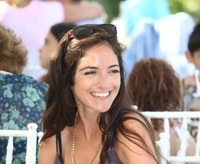Behind the science:
Response of fluorescence morphs of the mesophotic coral Euphyllia p...
2019, April 17
Posted by Veronica Radice
Fields
Physiology
Molecular ecology
Focusgroups
Scleractinia (Hard Corals)
Locations
Israel - Red Sea
Platforms
Land-based
Rebreather
“Effect of ultra-violet radiation on different fluorescent morphs of mesophotic coral”
What was the most challenging aspect of your study (can be anything from field, lab to analysis)?
Counting zooxanthellae cells. Whoever is involved with coral physiology studies will relate to the hours spent counting algal cells under the microscope. Also, since I am new to the studies of DNA damage I had to catch up on the literature and learn some new methods, but although learning a new technique is challenging, it is also interesting and leads a new set of questions.
What was the most memorable moment in undertaking this study?
Subjecting mesophotic corals to the high light intensities of Eilat was risky and I was afraid of how they would be affected. During the experiment, every day I observed the corals and crossed my fingers that they will survive. Watching these amazing corals withstanding the harsh conditions was mind blowing. This observation also led us to realize that the mesophotic Euphyllia paradivisa exhibits tissue contraction as a response to ultra-violet radiation, a mechanism known only from shallow corals.
What was your favorite research site in this study and why?
The sampling site of Euphyllia paradivisa is in-front of the Dekel Beach. This site is not the most attractive diving site in Eilat since it is quite turbid, and the coral cover of the shallow reef is not impressive. But, as you dive deeper, the reef becomes more and more developed and at ~35 m you reach the Euphyllia paradivisa fields, a memorable sight.
Other than your co-authors, with whom would you like to share credit for this work?
Dr. Tali Treibitz and Dr. Derya Akkaynak for the help with the spectral analysis, Prof. Yossi Shilo and Dr. Ron Jachimowicz who advised me on the DNA damage analysis, the technical and administrative staff of the Interuniversity Institute for Marin Sciences in Eilat for making their facilities available, our diving officers Oded Ben-Shaprut and Ofir Hameiri who help with the dives, and our great lab members (then and now) Lee Eyal-Shaham, Tom Shlesinger, Tal Amit, Hanna Rapuano, Raz Tamir, Bar Feldman, Mila Grinblat, and Nati Kramer for their support.
Any important lessons learned (through mistakes, experience or methodological advances)?
I would have loved to incorporate more of the DNA damage analyses. Due to the lack of experience on my hand in this territory, I did not evaluate any of the repair capabilities of the corals. I would also wish I could better quantify the amount of mycosporine-like amino acids and separate them to the different types since this might be a difference between the different fluorescence morphs. Unfortunately, I could not get my hand on standards nor I had the ability to prepare my own. I did learn to adjust my work, experimental design and analyses to mesophotic corals, corals that have a different set of optimal conditions and requirements.
Can we expect any follow-up on this work?
Currently, my work is mainly focused on testing the major hypotheses regarding coral fluorescence in mesophotic ecosystems, therefore, this is only the first paper in a series of experiments which are aimed at getting a glimpse into mesophotic corals’ physiology and maybe understanding what fluorescence contributes (or perhaps not contributes) to corals in the unique mesophotic ecosystem.
Featured article:
|
|
Response of fluorescence morphs of the mesophotic coral Euphyllia paradivisa to ultra-violet radiation | article Ben-Zvi Or, Eyal G, Loya Y (2019) Sci Rep 9:5245 |

|


